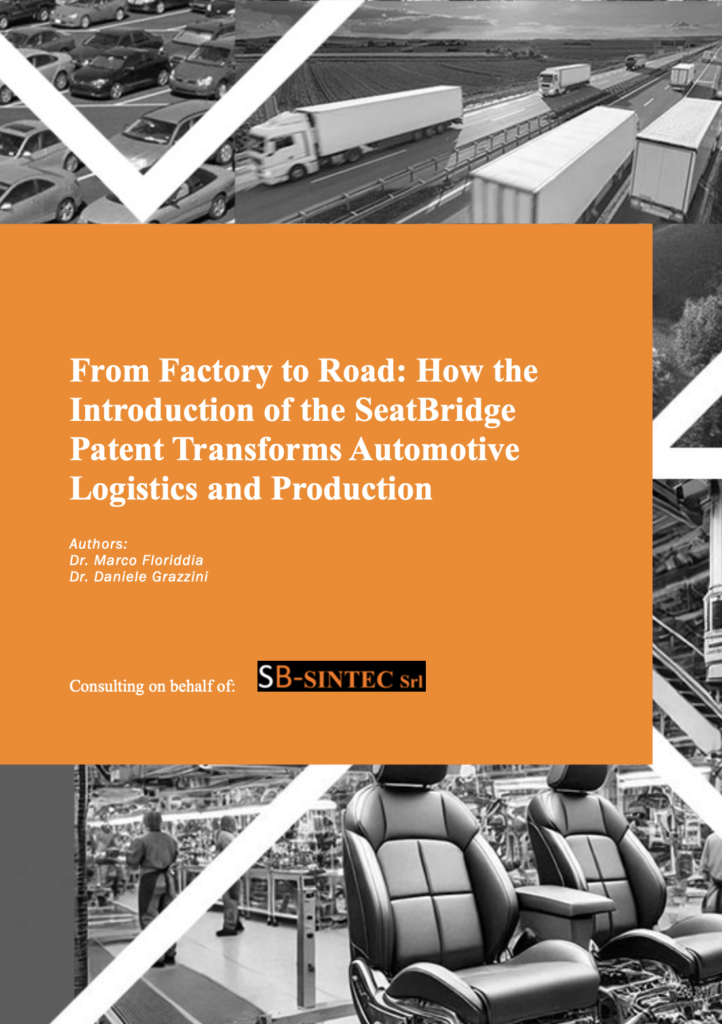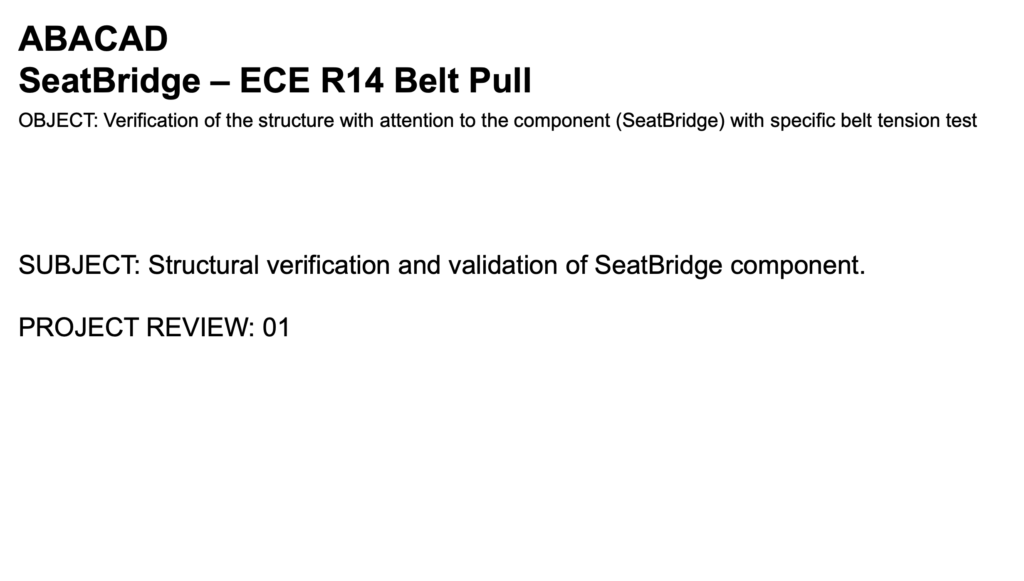Seatbridge studies and details
Here you can find papers about Seatbridge that highligh some aspects or provide data about studies or simulations performed:

From Factory to Road: How the Introduction of the SeatBridge Patent Transforms Automotive Logistics and Production
Authors:
Dr. Marco Floriddia
Dr. Daniele Grazzini
The Current State of the Automotive Market
The study starts with an analysis of the European automotive sector, exploring the economic challenges, shifts in consumer behavior, and the rise of electric mobility. One of the biggest takeaways? While sustainability is the future, inefficiencies in logistics and production are holding back real progress.
Revolutionizing Logistics with SeatBridge
Traditional vehicle production requires multiple shipments of separate seat components, consoles, and support structures, which leads to:
- Higher transportation costs
- Increased CO₂ emissions
- Complex internal logistics at OEM plants
With SeatBridge, all of this changes. The system enables the Front Seat Assembly (FSA)—a fully pre-assembled, pre-wired unit that combines the front seats, central console, and structural supports into a single component. This means fewer shipments, streamlined inventory management, and massive reductions in logistics complexity.
Measurable Efficiency Gains
By implementing SeatBridge, manufacturers can expect:
✅ 13.7% reduction in logistics costs – fewer shipments, lower handling costs, and better space optimization.
✅ 12.2% decrease in CO₂ emissions – optimized truckloads and fewer miles traveled.
✅ 30% faster final assembly – simplified installation thanks to the FSA’s one-shot mounting system.
Into the Factory: The Impact of the
SeatBridge Patent on Internal Logistic
Optimizing Internal Logistics with SeatBridge
In automotive production environments, internal logistics efficiency is often hindered by the complexity of pre-assembly operations, material handling, and storage of front seat components.
Challenges with Traditional Systems
Conventional internal logistics require:
• Multiple stations for assembling seats, consoles, and support structures
• Extensive use of trolleys and movement space
• Higher risk of errors and slowdowns in pick & place operations
SeatBridge: An Integrated Architecture for Internal Logistics
With the FSA (Front Seat Assembly) system, SeatBridge enables the reception of a single pre-assembled and fully-wired unit. This allows:
✅ Elimination of up to 5 intermediate stations in the seat assembly line
✅ 40% reduction in intermediate warehouse space
✅ Zero multi-picking, with simplified Just-in-Sequence flows
✅ 50% reduction in internal handling times due to fewer movements
A New Standard for Internal Efficiency
The solution is particularly effective for multi-model platforms and OEMs facing high configuration variability. In simulated scenarios with volumes >100,000 units/year, overall savings on internal logistics operations reach 18.4% annually, with an operational ROI under 12 months.
A SeatBridge installation for a car and a seat currently on production
Author:
ABACAD Engineering
SeatBridge: A Smarter Way to Install Car Seats 🚗🔧
The automotive industry is constantly evolving, with manufacturers looking for ways to improve efficiency, reduce costs, and enhance the driving experience. SeatBridge is a game-changing innovation that simplifies vehicle assembly while improving interior space and design.
Our latest study explores how this patented solution transforms the way front seats are installed in vehicles, eliminating unnecessary complexity and optimizing both production and user experience.
What’s Inside the Study?
A Revolution in Seat Installation
Traditionally, front seats are mounted using multiple brackets attached directly to the car body. SeatBridge eliminates these brackets and replaces them with a single, structurally reinforced platform. The result? A one-shot mounting procedure that allows for a pre-assembled Front Seat Assembly (FSA)—fully wired and ready to be installed in one step.
Simplified Car Body Design
By integrating SeatBridge, manufacturers can remove seven structural brackets from the body-in-white (BIW), making the design simpler, lighter, and more efficient. This also leads to increased body resistance, enhancing vehicle durability and performance.
More Interior Space & Comfort
With traditional seat brackets gone, passengers in the back benefit from:
✅ 170 mm more foot space
✅ No protruding metal parts under the seats
✅ A single, stable carpet per side
✅ Easier cleaning and a more premium aesthetic
Weight Optimization & Structural Gains
- Removed brackets: 3.925 kg
- SeatBridge weight: 4.696 kg
- Net impact: A negligible weight increase, but with significant structural benefits
Designed for Seamless Integration
SeatBridge doesn’t change the seat’s H-point or positioning, meaning it can be seamlessly integrated into existing production lines without impacting seat comfort, safety, or adjustability.
Crash Test Analysis: SeatBridge’s Performance in a Front Impact
Author:
ABACAD Engineering
Ensuring passenger safety is a top priority in automotive engineering, and the latest SeatBridge crash test analysis delivers valuable insights into its structural behavior under extreme conditions. Our study, conducted following ECE R14 regulations, evaluates the response of the SeatBridge system under belt tension and front impact scenarios, pushing the structure beyond standard load limits to assess its safety margins.
Key Findings from the Study:
🛠 Structural Verification & Belt Pull Test
The SeatBridge component underwent a rigorous structural validation test to measure how it reacts under belt tension forces applied to the torso, pelvis, and seat center of gravity (COG). The load was applied in two phases:
- 100% of the standard load – The SeatBridge remained within the acceptable plastic strain limits, ensuring structural integrity.
- 120% of the standard load – The system showed localized areas of high stress but remained functionally intact.
📏 Deformation & Structural Integrity
- The maximum displacement recorded was 120 mm, occurring in the area of highest deflection.
- Plastic strain values remained below critical limits at 100% load but slightly exceeded the safety margin at 120%, indicating potential material fatigue points.
🔩 Connection Strength & Load Distribution
- The analysis measured the forces acting on the SeatBridge’s connection points with the vehicle’s BIW (Body-in-White) and seat guides, revealing stress distributions under crash conditions.
- The highest recorded force was 15.35 kN, absorbed efficiently through multiple anchoring points.




